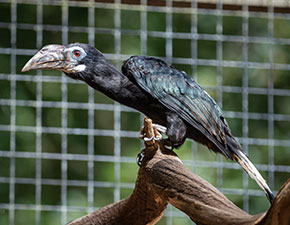
East African Crowned Crane
Balearica regulorum gibbericeps
IUCN red list status:
Endangered
For more information, please visit iucnredlist.org

Wetlands and open grasslands of East Africa

A variety of plants, seeds, grain, insects, frogs, worms, snakes, small fish and the eggs of aquatic animals.

Breed from December to February. Have 2-3 eggs which are incubated for 28-31 days and then fledge the nest between 56-100 days.

In the wild up to 22 years and in captivity up to 25 years
East African Crowned Crane
About the East African Crowned Crane
In the wild, East Adrican Crowned Crane’s live in flocks of 30-150 birds. One of two subspecies of Balearica regulorum, they can be visually distinguished by a larger area of red skin above the white cheeks. They are the only species of crane that perches in trees.
Did you know?
During breeding season, they display behaviour involving dancing, bowing, and jumping, they also make a honking noise.

